Stitch by Stitch
Neighbors Work to Mend a Broken Border
It is chilly now in the Big Bend of Texas, and dry as a bone. Most all the leaves blew off the pecan trees in the last windstorm, carpeting Marfa in a potpourri of yellows, browns, and deep orange hues. The space heaters churn away to take the edge off the chill, but not much more. I find myself going to bed earlier and earlier. My dog agrees and decides to furiously dig at all my cheap, store-bought quilts to create her own bed of stuffing and cloth.
A couple of mornings after the ripped-up bed-cover incident, I happily venture to the Quilt and Craft show at the First Presbyterian Church in Alpine. Customers weave in and out of the pews, which, being it’s a Saturday, serve as a display gallery for hundreds of finished quilts and quilt tops. The design choice is almost overwhelming, and people take their time deciding, studying the patterns, allowing the church volunteers to lift and unfold the quilts with care.
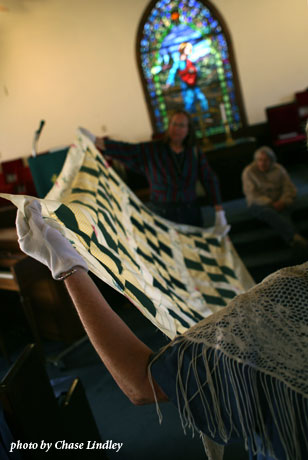
I wander about taking in the colors and designs, and find myself standing next to an older woman as she caresses each quilt. I apologize for startling her. Joan Webb says, “No, that’s fine.” Her reverie interrupted, she smiles up at me.
“All this,” she says, looking up at the throngs of people, “helps me to remember my own family and the quilting parties we held years ago. Wouldn’t it be wonderful to hold a giant quilting bee at the river’s edge? It could be so easy.” She pauses to think as reality seeps back into her musing. “Well, maybe not now.”
This is not a typical quilt sale. The quilts are from Boquillas del Carmen. Until recently the small Mexican community was easily accessible: a five-minute boat trip across the Rio Grande and a short donkey ride into town. Tens of thousands of tourists visited each year. Then came 9/11, and in May 2002, the U.S. government closed the unofficial “class B” river crossing. Now only the hardiest tourists make the arduous seven-hour trip overland to Boquillas. And the community is struggling to prevent a slow, painful death.
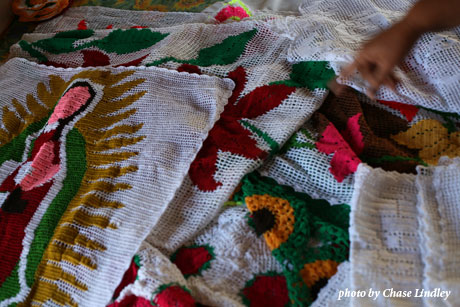
Over the last eight months, a band of volunteers with a Terlingua-based group called Fronteras Unlimited has made multiple trips to Boquillas, bringing community-donated fabric, copper wire, beads, and assorted accoutrements for handicrafts, and returning with quilts, quilt tops, crocheted table covers, walking sticks, and tons of elaborate, copper animal sculptures. Many shoppers at the church donated fabric to the effort months ago, and one can hear their cries of recognition as they discover what the artisans have done with the raw material.
I tell Webb how there used to be an event called Good Neighbors Day sponsored by Big Bend National Park, just a fun, cultural exchange that symbolized the connection between the two communities. Many years ago, President Franklin Roosevelt hoped that Big Bend could be a place where the border mattered little. As early as 1944, FDR was quoted as saying, “I do not believe that this undertaking in the Big Bend will be complete until the entire park area in this region on both sides of the Rio Grande forms one great international park.” World War II interrupted the original discussions between FDR and Mexican President Manuel Ávila Camacho. Negotiations between the U.S. Department of the Interior and Mexican authorities resumed in the late 1990s, but were cut short again by the so-called War on Terror. “History repeats itself, I guess,” Webb says.
I have a hard time picking the quilt I will buy among the hundreds on display. Finally I decide. Later, with the quilt laid out on my bed, I spread each corner to its fullest extent. With overhead light, I can see the design more closely. There are six squares in a rectangular design repeated 40 times. Within that simple design there seems to be a world of confusion, hope, and horror jumbled together, a unique mix of traditional patterns next to pop-art flowers and stripes.
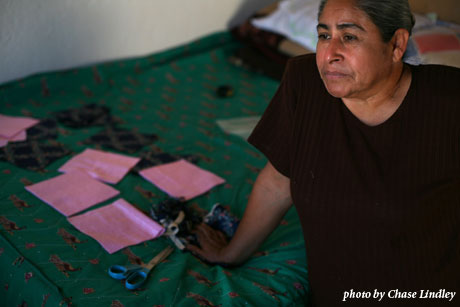
At the quilt sale’s payout table sits a clearly joyful Cynta de Narváez. She is the guiding light behind Fronteras and one of the most inspiring people I have ever met. Tall and regal, she reminds me of Katherine Hepburn. At a time when I wondered how to build a life in West Texas as a single woman from New York, I was introduced to Cynta as if by divine intervention, and much of the anxiety dissipated. A little like me, she grew up in Manhattan, studied in all the right schools, and even spent a trinket’s worth of time as a debutante and a preppy, but eventually left it all to work as a riverboat guide in Terlingua. The people of Boquillas and the “sister” towns all along the Mexican side of the river became not just fellow boatmen, tourist guides, and cooks, but neighbors and friends. They gathered around her in times of pleasure and helped when a mysterious illness impaired much of her motor function.
For residents like Cynta, the river is and always has been a geographic feature, not a boundary. By the turn of the 20th century, a pattern of trade and travel between the communities on either side of the Rio Grande (or Rio Bravo) became an established fact of life. Both Mexico and the U.S. participated in quicksilver mining, candelilla wax making, ranching, and the fur trade. Towns like Boquillas, Lajitas, and Santa Elena on the Mexican side became the villages where the wax makers and ranchers lived, and the Texas side housed trading posts, banks, stores, and the mines themselves. For generations as this dynamic continued—Texas holding the money and jobs, and Mexico the workers—people felt disassociated from one another’s governments and dependent on cross-border trade to survive.
When the unofficial river crossings were shut down in a panic over national security, the two distinct cultures of Terlingua and Boquillas, which had intertwined and shared the river for their livelihoods, were forced to confront the Rio Grande as a border. People shouted to one another from opposing riverbanks instead of conversing normally, supply lines were cut, and the neighbors took to staring at one another in disbelief.
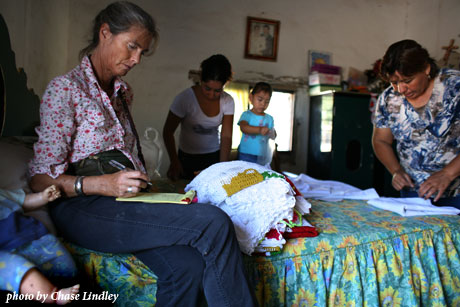
Cynta and Danielle Gallo started Fronteras Unlimited to “stabilize the border area of the Big Bend using free trade commerce, education, and the cooperation that has traditionally made the Big Bend the uniquely peaceful border it has been in the past,” according to the group’s Web site. In addition to ushering the quilts and handicrafts through customs, they coordinate a range of donated equipment, clothes, books, and art supplies for children, and organize workshops in skills such as sewing quilts and building town water pumps. When asked how she would term what she does for Fronteras Unlimited—customs brokering? advocacy? teaching?—Cynta pauses for a moment, reviews the possible answers, and settles on one short line: “I am a neighbor with some time on my hands.”
In early November, Chase Lindley and I set off from Marfa on a Sunday at 3 a.m., I with audio recording equipment for a documentary I am doing for Marfa Public Radio, and he with a still camera, lenses and small tripod. We wanted to document one of Cynta’s trips to Boquillas. The journey took us through the border crossing at Del Rio, then to Ciudad Acuña, Melchor Múzquiz, and all the polluted coal towns between, over treacherous dirt roads past Las Norias (where candle wax is still made) and finally a full loop around to Boquillas del Carmen. During the 600-mile trip, we hit at least two rabbits and puncture a tire on a dirt road about 20 miles away from the dirt road we were supposed to have taken. Bruised and battered, I was ready to weep by the end, when my emotions were steadied by the sight of the Mexican view of Big Bend’s Chisos Mountains at sunset.
I am told that the dirt road that runs through Boquillas used to vibrate with people selling trinkets, games, rocks, and gems, and bustle with crowds of tourists and students on spring break eating at José Falcón’s restaurant, sleeping at the Buzzard’s Roost, and drinking at the Park Bar. With less than half the usual population still eking out enough of a living to stay, the town seems to be fading away, literally. Save one building that must have used some hearty paint years ago, most all the handwritten signage is faint. There is one central well for water at the end of the main road, and the water is sweet and delicious. Boquillans have rigged a water pump and hose system, which gets rotated among the houses and saves on carting buckets up the steep hill. Only a few of the adobe houses have electricity, and that is because of the volunteers from Fronteras Unlimited. Without the solar-power generated electricity one can hardly discern which house is abandoned or not, the dividing line is so thin. Most everyone has run out of propane, and the women cook on kitchen stoves that burn wood. There’s very little recorded music played outdoors anymore. Between the diesel trucks struggling to make it up the hill, the most distinct sounds during the day are of chickens, roosters, and the goats with bells on. Occasionally you hear children playing and adults laughing, but the town seems to echo rather than perform.

One of our first stops is the store and house of Maria de la Luz Chávez. She has been running the main Boquillas tienda for seven years, but it has been open for 25. When the Federales had a checkpoint a couple of miles down the road, it was much better, she says. The store stocked plenty of fresh food, fruit, and even vegetables. Now trucks only come to town with eggs and fruit once a week. Much of the limited supplies seem to be surplus food donated by the government of Mexico. There is one kind of cookie, and Cynta makes a point of buying a box for the family that she stays with during these monthly trips. She and Maria discuss the treadle sewing machine that has broken down again, though a volunteer from Terlingua tried to fix it last month. It is not a huge surprise for Maria since the machine had been passed through the family for generations. Now she wants an electric one, just like you see in Múzquiz, a mining city about 100 miles north of Monclova. Cynta repeats her familiar refrain, “When I return in December.”
When Cynta laughs, you can just barely resist smiling, and the whole town seems similarly cheered by her optimism. Chase and I struggle to keep up with her brisk steps around town.
Whenever we come within 300 feet of someone’s adobe house, Cynta mildly whistles as a polite warning. It is a cultural tradition in this part of Mexico since there are no phones. Most everyone seems happy to see her, bringing over some new work and urging that it be taken back to Terlingua for sale. There is almost always some discussion about getting more of the solar panels for electricity to run sewing machines. Cynta says that most of the material the town’s women desire is Dacron or polyester because it lasts longer, but adjusting to the new market, women have started taking special orders from the U.S., and cotton is preferred.
After a day’s worth of picking up quilts and crafts from people in town, I can’t help but wonder if the time will come when Cynta cannot fulfill this great need anymore. She knows how difficult the trip can be and that willing volunteers will eventually drift away. “When the river was low this past summer,” Cynta tells me, “I would throw them a pouch full of cash [to a helper on the Mexican side] from the river’s edge. That’s how they got their money, but now that the river is high, I don’t have that kind of strength to throw hard enough.”
She tells people in Boquillas at each stop that come April 2007, she wants them to have figured out their own system for selling these items. A big part of that is working cooperatively, she says repeatedly.
Maria Ignacia Ureste, the mother of five children, the youngest four years old, is not thrilled about working cooperatively with neighbors to make these quilts, even though her husband, Gerardo, is converting an adobe house to a quilt shop for the women in town. At the beginning of this process in 2002, many families didn’t see the point in gathering for a quilting bee and preferred working in their own homes. There was much competition and anger about who was getting more work. Cynta blames the extreme economic distress. She doesn’t want to come across as a Terlingua hippie telling people what to do, trying to impose an idealistic cooperative system on a society of tight-knit family clans. But she is committed to helping them, so fostering healthy competition and the capitalist model seems the best bet for now.
“You’ll see,” she tells them. “Don’t you want to make more money for less work?”
Speaking with anyone in Boquillas today, you’ll find little hope that the tourist economy will return, and much fear of what will take its place. I was surprised to discover near-universal dismay at the decision to close the crossing on both sides of the river. Increased bureaucracy at U.S. border crossings seems to make U.S. and Mexico parks officials, the Border Patrol, Federales, and townspeople in Terlingua, Boquillas, and surrounding communities feel less secure. Where once someone in a border town like Boquillas may have alerted an official of suspicious activity or strangers gathering along the river, the ability to communicate vital information is now practically lost unless you count yelling across a river as an appropriate solution. In Nevie Owens and Buckner Cooke’s powerful new documentary film, Mexiphobia, Big Bend state Rep. Pete Gallego attempts to explain this brand of political dysfunction: “You know the reality is, if you live in an ivory tower, you don’t have an opportunity to see real life, and so for many members of Congress who don’t see it, don’t live with it, they don’t relate to it and understand how their decisions impact, in a very real way, a person living along a border.”
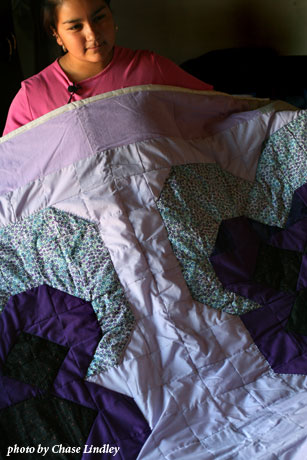
A few days before we made the grueling trek to Boquillas, the recently elected governor of Coahuila, Humberto Moreira, toured the area, bottoming out on the same dredged-out dirt road, to meet the 90 or so Boquillans who still manage to live there. He promised the roads would be paved and the borders reopened and electric lines run from the United States. Everyone nodded politely and offered up congratulations on his election, but no one was convinced. “They don’t really have much faith in any government, ours or their own. What they have faith in is us, their neighbors and friends,” says Cynta.
Why the U.S. border with Mexico is considered so much more vulnerable to terrorists than the one shared with Canada, where there is actually an international park with the U.S., is the subject of a longer article. Some consider it racist; fears about invading Mexicans date all the way back to Pancho Villa and his raids on Ojinaga, and lore persists about bandits hiding in Big Bend, fomenting plots to attack ranches on the Texas side. No one was mor
surprised that the informal crossings were closed than the National Parks Service itself. There was a lot of fin
er pointing, and a journalist was blamed at one point for writing about the informal crossings, thus alerting Homeland Security. Cynta tells the story of a desperate Mexican man who had just learned that the river was secured and closed for crossing. When told he could not float his boat over and buy food on the U.S. side as he always had, he grabbed Cynta by her wrists and hissed, “Do I look like an Iraqi? Do I talk like an Iraqi?”
A more recent fear is that drug-trafficking operations in Mexico will take advantage of the desperate need of these poor communities. Under the cover of narcos, terrorists might infiltrate as well. In this scenario, ironically, towns like Boquillas may become unwitting pawns in terrorist activity, the exact outcome the Bush administration had hoped to avoid. “I have this analogy I make to a healthy plant,” says Cynta. “If you have a healthy plant and it is getting enough fertilizer and water, there are no parasites. It is a healthy plant, green and alive. But if you draw a line like a border through the center, one half is going to get the nutrients and the other is not, and you’ll see the parasites move in.”
So Fronteras tries to bridge the line while Boquillas learns to cope. Eighty-one quilts were sold at the Alpine show, and with the money from the sales of copper-wire dragonflies, scorpions, peacocks, and poodles, table-top covers, and straight-out donations, Cynta counts the gross profit at $15,000. Cynta says there was a bidding war for the largest quilt by Juanita Luna. She had worked on it for eight months, and it was still unfinished because she ran out of fabric.

Christmas is coming, and Cynta will return to Boquillas with cash for food, propane, and presents, along with the working elements of survival: solar panels, generators, and inverter boxes that allow the sewing machines to run. “I think people really want to give to something here, local, in the neighborhood, especially when it means that the people of Boquillas can stay in Boquillas, safe and without threat,” she says. “Even the most conservative Republican can’t dispute how important it is to keep Boquillas people in Boquillas, rather than force them into humiliating situations like drug trafficking or working illegally in Midland or Odessa.”
Karen Bernstein is an award-winning producer of documentaries currently working for Matinee Media and Marfa Public Radio.


